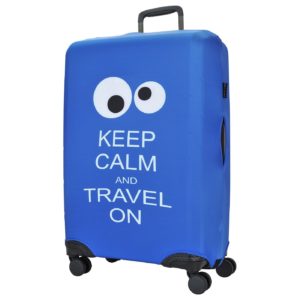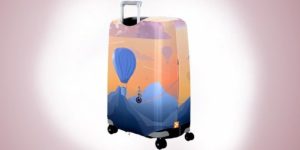In addition to its main function, a suitcase performs a protective function: it preserves the appearance of folded items and prevents them from getting wrinkled and dirty. At the same time, travel luggage itself must be protected from environmental influences, otherwise its contents may be damaged. To prevent this from happening, you should purchase a case. So how do you choose one?
Why do you need a case at all?
 The simplest suitcase costs several thousand. The cost of branded products made from expensive materials and with a well-designed sectional system reaches and exceeds the mark of 100 thousand rubles. However airport forklifts don't differentiate between luxury and cheap travel bags. They are treated the same: both categories of goods can be scratched, torn, broken or dirty during transport.
The simplest suitcase costs several thousand. The cost of branded products made from expensive materials and with a well-designed sectional system reaches and exceeds the mark of 100 thousand rubles. However airport forklifts don't differentiate between luxury and cheap travel bags. They are treated the same: both categories of goods can be scratched, torn, broken or dirty during transport.
Important! Owners of expensive suitcases cannot do without a cover.
The accessory is also useful if the lining of the travel baggage is already slightly damaged or has persistent dirt.. Defects will simply be hidden under a protective colorful bag. The issue of style is resolved in the same way: with the help of a cover, you can make the suitcase begin to complement the image of the hostess.
Other reasons to buy:
- you will be able to bypass the rule of additional baggage packing at the airport (and thereby save money);
- packed items receive additional protection (nothing will happen to them, even if the suitcase lock fails);
- The cover makes it difficult to steal.
The simplicity of caring for the accessory is also attractive. It is much easier to wash it than to clean the surface of a travel bag.
Criteria for choosing a suitcase cover
Key parameters:
 capacity;
capacity;- material;
- method of care;
- manufacturer.
The third point follows from the second. So, to remove dirt from a PVC cover, it is enough to wipe it (in difficult cases, they resort to liquid powder). If the stain does not disappear after this, the accessory will have to be thrown away. It still won't withstand machine washing. But it is perfectly tolerated by lycra items, you just need to set the mode correctly:
- the temperature should be less than 40 degrees;
- powder is suitable only liquid;
- spinning is contraindicated (some manufacturers allow it, check the details).
Dry Lycra and PVC accessories away from direct sunlight and heating devices.
How to decide on the size?
Many manufacturers use their own metric system. Because when choosing, it is better to rely on the dimensions of a particular suitcase and cover, and not on standard qualifications of standard sizes. The latter looks like this:
- S. This accessory is suitable for the smallest luggage (height less than 56 cm).
- M.The cover is suitable for travel bags whose height does not exceed 65 cm.
- L. These products will help protect suitcases up to 80 cm high.
- XL. For very large bags.

Important! There are 2 more frequently encountered qualifications (the marking and the maximum allowable suitcase height for this marking are indicated in brackets): NP (M - up to 71 cm, L - up to 80 cm) and SP (S - up to 55 cm, ML - up to 74 cm, LXL – up to 84 cm).
To find out the dimensions, you will have to take measurements (or look at the tag, label). The measurement is carried out by relaxing the tightening locks and placing the suitcase vertically (if it is plastic or metal, you don’t have to do so). The dimensions of the wheels do not add to the obtained values - holes for them are provided in the design of the covers.
Sometimes sizes alone are not enough. If the bag has side pockets and handles, or has sloping or cut edges, these points also need to be taken into account.. Useful notes on this matter:
- smooth edges and protruding wheels require a smaller case;
- looser models are suitable for square shapes and recessed wheels;
- if the side handle does not fold, then the case should either come with a slot for it, or have a slightly larger size.
Important! The best option is an elastic cover (even better are models with drawstrings). Even if you mess up the size or buy a slightly smaller or larger suitcase over time, such an accessory will still fit.
Which material is better to choose?
 Non-fading elastic and waterproof fabrics - spandex, neoprene - are ideal. Especially when the covers made from them at the seams and drawstrings are treated with water-repellent liquids. If the manufacturer is not concerned about this issue, then you should purchase impregnation yourself.
Non-fading elastic and waterproof fabrics - spandex, neoprene - are ideal. Especially when the covers made from them at the seams and drawstrings are treated with water-repellent liquids. If the manufacturer is not concerned about this issue, then you should purchase impregnation yourself.- Products made from PVC film also perfectly protect against precipitation and splashes, but they are more affordable at the price of previous options. The low cost is offset by poor elasticity: after strong stretching, such an accessory will not return to its previous shape. Another weak point is the seams. Both glued and stitched ones diverge equally quickly. A few trips and the problem will appear in the drawstring area.
- You shouldn't expect such troubles with lycra. The fabric is beautifully sewn and used to create clothes. In addition, it has no equal in terms of elasticity. Even if you put a cover on a suitcase that is not the right size for it, the accessory is 96–98% likely to return to its shape after removal.
- Ordinary fabric protective bags cannot boast of such extensibility, but they can be washed as much as you like. This feature will appeal to people who travel frequently and those who have children and animals, because of which the likelihood of staining increases many times over.
Fabric products usually breathe well. This property will be useful for those who have a suitcase made of genuine leather, which does not tolerate complete sealing.. In this case, the cover itself should not be made of thin or transparent material. Ideal option: the threads in the fiber are located as close to each other as possible. In this case, the sun’s rays, which are harmful to leather products, will practically not penetrate through the gap between the threads.
Brands worth choosing
Brands worth checking out:
 Mettle. A domestic brand that produces bags made of non-fading, moisture-resistant material. Seams and lock areas are additionally protected.
Mettle. A domestic brand that produces bags made of non-fading, moisture-resistant material. Seams and lock areas are additionally protected.- LOQI. German quality combined with a huge variety of prints. The products comply with the Oeko-Tex standard.It is assigned to highly hygienic and safe products that are suitable even for very young children. Moreover, not only the lining fabric is tested, but also zippers, buttons, lining and other elements of the bag.
- Samsonite. One of the oldest brands specializing in the production of hand luggage. In addition to their quality, his products also stand out due to their appearance. The brand's designers constantly receive awards.
- Routemark. It produces practical accessories that are easy to care for (they can be washed in any mode). Other advantage: You can order an item from the manufacturer with a unique design or inscription, including a corporate one (it works not only with retail consumers, but also with wholesalers).
Is it possible to make a case with your own hands?
 The easiest option: use a T-shirt (for very large luggage, take a knitted dress). The item must initially fit the size. To correctly determine them, you need to unfasten the tightening locks and elements, put the suitcase, measure its height and width, and then add 5–10 cm to the resulting measurements.
The easiest option: use a T-shirt (for very large luggage, take a knitted dress). The item must initially fit the size. To correctly determine them, you need to unfasten the tightening locks and elements, put the suitcase, measure its height and width, and then add 5–10 cm to the resulting measurements.
Next, check the size chart, select a wardrobe item and put it on the bag. During the “trying on”, it becomes clear whether the bottom needs to be trimmed, where to place the drawstring and holes for the wheels, as well as how to beautifully remove the sleeves (usually they are sewn inside or made into side pockets).
A more complex and expensive method - sewing. This is done like this:
- measurements and patterns are taken;
- a pattern is created based on the measurements obtained (don’t forget to transfer the handle and other important details to the diagram, and also add 1-1.5 cm for allowances);
- a test case is sewn according to the pattern (preferably from fabric that has the same properties as the material for the real accessory);
- fitting is carried out (during it it is easy to understand what was not taken into account when creating the first pattern);
- changes are made to the pattern;
- a finishing accessory is sewn.
When sewing, pay special attention to zippers (take tractor ones, not spiral ones). It is advisable to treat the locks with bias tape or put them under the lining. You should also check the material for translucency. If such a problem is identified, glue the material with non-woven material.


 capacity;
capacity; Non-fading elastic and waterproof fabrics - spandex, neoprene - are ideal. Especially when the covers made from them at the seams and drawstrings are treated with water-repellent liquids. If the manufacturer is not concerned about this issue, then you should purchase impregnation yourself.
Non-fading elastic and waterproof fabrics - spandex, neoprene - are ideal. Especially when the covers made from them at the seams and drawstrings are treated with water-repellent liquids. If the manufacturer is not concerned about this issue, then you should purchase impregnation yourself. Mettle. A domestic brand that produces bags made of non-fading, moisture-resistant material. Seams and lock areas are additionally protected.
Mettle. A domestic brand that produces bags made of non-fading, moisture-resistant material. Seams and lock areas are additionally protected. 0
0





